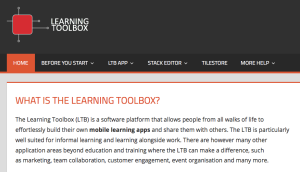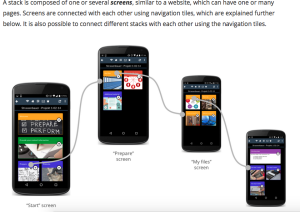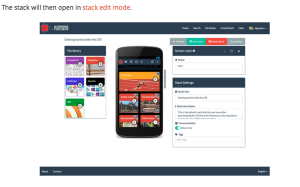Thoughts on “Digital divide 4.0” – Part Four: How to bridge the gap between formal and informal learning?
With my three latest posts I have presented reflections on “Digital Divide 4.0” (regarding the concept, see the first post). These reflections have been inspired by recent experiences with fieldwork for our ongoing EU-funded Learning Layers (LL) project and in particular with its key product the Learning Toolbox (LTB). In my second post I discussed, how this concept reflects the initial difficulties of our project work in the construction sector training centre Bau-ABC.
In this post I shift the emphasis to another part of the German vocational education and training (VET) system – to vocational schools. This is partly triggered by a recent working meeting with a vocational school teacher, who wondered, why their school was not included into our project. Indeed, for us in ITB and in the training centre Bau-ABC it is a key issue, how to bridge gaps between formal and informal learning when developing workplace-based learning. In my short answer I referred to the funding priorities that emphasised strongly the promotion of informal learning (and SMEs as target groups). In order to understand this it is useful to look back at the development of earlier policies to promote e-Learning or Technology-Enhanced Learning (on the one hand) and initiatives to promote professional development of teachers and trainers in VET (on the other hand). Yet, we need to ask, why the conceptual gap between parallel earlier policies and initiatives has remained. Moreover, we should reflect, how our work in the LL project could help to bridge the gaps.
Background: Earlier e-Learning as ‘alternative’ for institutionalised education and training
Looking back at the educational initiatives in 1980s and 1990s there was a gradual movement in efforts to create new opportunities for open learning. This was reflected in the terminology – ‘remote learning’, ‘distance learning’, ‘open distance learning (ODL)’, ‘blended learning’ – all these referred to different steps and measures to open access to education and learning. Suddenly, at the end of 1990s and at the brink of the ‘New Millennium’ there was a great hype on ‘eLearning‘. In the newer initiatives there was a clear tendency to push the institutionalised education (and the adult education movement) aside. Some protagonists tried to bring forward private providers and new ‘career spaces’ via commercial eLearning programs as the innovation leaders. This was reflected in the separate European funding opportunities for e-Learning of that time. However, concerning the projects on the uses of e-Learning by work organisations, I remember that they concluded that the take on eLearning provisions was low. Instead, wider European surveys – like the the ones of the project “ICT and SMEs” – provided valuable information on the ways that SMEs actually used to support (organisational) learning.
Shift of emphasis: Teachers and trainers in VET as ‘key actors for lifelong learning’
Whilst the above mentioned developments emerged from fringe areas in education and training policies, the next wave – the follow-up of the EU Lisbon Summit 2000 – was part of an overarching development of EU policies. In the field of education and training this took shape firstly in the European Commission strategy document Education and Training 2010 and the aim was to promote a digital learning culture to support global competitiveness of European economy. In the first phase this follow-up was promoted by European working groups and supported by commissioned follow-up studies. In particular the follow-up study for the Maastricht meeting in 2004 drew attention that the engagement of teachers and trainers (notably in vocational education and training (VET) was lagging behind regarding the promotion of digital learning culture.
This gave rise for the European Commission to introduce new initiatives to stimulate trans-national cooperation and European exchanges with different formats: the Eurotrainer surveys, the TTplus framework project, the network ‘Trainers in Europe’, the policy-makers’ Peer Learning seminars and the Europe-wide series of ‘regional’ consultation seminars for different stakeholder groups. Altogether these measures increased the European knowledge basis on VET teacher education and training of trainers across Europe. However, these activities did not provide a basis for common qualification frameworks – instead they recommended the continuation of such participative dialogue forums with emphasis on learning lessons from recent innovations.
Another shift of emphasis: Focus on digital media and mobile technologies to support informal learning
In the meantime the development of web technologies and the spread of mobile devices had given new impulses for technology-enhanced learning. This became manifest in the wider use of online learning platforms, e-portfolios and open educational resources (OER). Now, there was less talk of sidelining the educational establishments but promoting specific initiatives (the networks of open universities) or by joint services (for consortia of member universities). Parallel to this there was a need to explore, how new forms of online learning could be promoted in working life, in particular in such occupations that were characterised by SMEs (and not catered for by university-industry alliances). Partly, the newer policy priorities were looking for genuinely work- and organisation-based modes of (informal) learning, partly for ways to reduce training costs by promoting flexible learning alongside work.
The experience with Learning Layers: The role of trainers and facilitators as change agents
In my two previous posts I have discussed the issue ‘digital divide’ in its current forms (“Digital divide 4.0”) in general and in the light of our fieldwork in the Learning Layers project. Also, I have given insights, how we have made progress with our application partners in the construction sector training centre Bau-ABC and in the network for ecological construction work (NNB). In both cases we have not relied on stand-alone tools or self-learning of practitioners (with the help of online tutorials). With the Learning Toolbox we have managed to develop – in a co-design process with the users – an integrative toolset that meets several basic needs and is easy to expand by the users themselves. Also, we have trained the pioneering users in joint learning sessions to work as peer tutors and mentors in their own communites and networks. However, the wider use has always been dependent on the interest of new users (and anticipation of practical benefits for them). Here, the success factor is to introduce Learning Toolbox as one instrument to promote knowledge sharing, coordination of tasks and real-time communication – and in this way work-related and organisational learning.
Follow-up: What role for teachers and trainers in promoting digital agenda in vocational education?
In the light of the above we (the partners working with the construction pilot of the LL project) have good reasons to consider, what role could teachers in vocational schools play in the follow-up phase. In the German dual system there is a constant challenge to improve cooperation between the fundamental learning venues: enterprise (workplace and the intermediate training centre) and school. In this respect the Learning Toolbox will offer new prospects. Also, the new importance of European mobility schemes (training of apprentices from Spain, Greece etc. in Germany) and the integration schemes for refugees provide new challenges for teachers and trainers in VET. Here, we believe that the introduction of Learning Toolbox could help different parties work together. I will get back to these issues soon.
More blogs to come …



